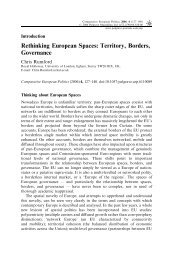Europeanisation, National Identities and Migration ... - europeanization
Europeanisation, National Identities and Migration ... - europeanization
Europeanisation, National Identities and Migration ... - europeanization
Create successful ePaper yourself
Turn your PDF publications into a flip-book with our unique Google optimized e-Paper software.
Illusions of European integration 49<br />
authority to the only credible repositories of democratic practice, the nation-states.<br />
Different versions of such an arrangement, enshrining the ideal of ‘ever closer union<br />
of peoples’, have been mooted: including a federal state sustained by a Constitutional<br />
Court on USA or German models. But constitutions have to have within them<br />
the potential for adaptation so that they can address circumstances unimaginable<br />
to their formulators. The experience of the USA, Canada <strong>and</strong> Australia suggests<br />
that a written constitution becomes a battleground between ideological groups<br />
seeking to exp<strong>and</strong> or limit the central state <strong>and</strong> alter its rulings on fundamental<br />
rights, <strong>and</strong> that the supposedly neutral Constitutional Courts become politicised in<br />
the process. In the USA such conflicts over states’ rights tied to the issue of slavery<br />
led to civil war.<br />
A major difficulty of codifying decisively the respective spheres of the EU <strong>and</strong><br />
nation-states is that nations change in what they perceive to be their core regulatory<br />
concerns, as they encounter the challenges of an ever-changing world. If that is<br />
so even within a single state, a constitution formulated for a union of many nationstates<br />
will almost certainly be the site of perpetual political conflict.<br />
Conclusion<br />
The movement for European integration is justified by several rhetorics – the<br />
extension of democracy <strong>and</strong> human rights, enhancing economic progress, becoming<br />
a world actor, taking responsibility for European security. All of these have their<br />
point, but this is above all an elite-driven, even an Imperial (Franco-German)<br />
project, infused with a strong subterranean desire to contain the resurgence of<br />
historical national differences at the very centre, as well as on the eastern fringes,<br />
of Europe. The drive to integrate, however, exacerbates the problem. Centralising<br />
powers in European institutions raises expectations of what the EU can deliver<br />
while multiplying the problems it must resolve, <strong>and</strong> it intensifies the gap between<br />
elites <strong>and</strong> peoples by transferring powers from national parliaments to arcane <strong>and</strong><br />
all but unaccountable institutions. A resentment of an invasive Imperial centre is<br />
the classic breeding ground of European nationalism, especially when the Imperial<br />
elites are divided by their national visions of Europe.<br />
Myths <strong>and</strong> symbols provide key components of underst<strong>and</strong>ing <strong>and</strong> directing<br />
change. Even in normal times, as Michael Billig (1995) has demonstrated, the<br />
discourse of politicians is laden with national myths, images <strong>and</strong> a national rhetoric,<br />
often derived from warfare, which insiders take for granted. The legend of the nation<br />
is of a community knit by love <strong>and</strong> common sacrifice. Its myths <strong>and</strong> symbols orient<br />
its members to fundamental values – to homel<strong>and</strong>, the defence of ‘irreplaceable<br />
cultural values’, <strong>and</strong> to the freedom of its people. Images establish a common bond<br />
between leaders <strong>and</strong> led <strong>and</strong> legitimise even in ‘normal times’ difficult decisions<br />
– the imposition of heavier taxes in economic difficulties, the redistribution of<br />
resources between richer <strong>and</strong> poorer regions or classes. At times of extraordinary<br />
crises – the outbreak of war or economic depression – mythic images of kinship can<br />
inspire great sacrifice on behalf of the nation-state. One of the characteristics of<br />
such myth–symbol complexes is that they remain empty or alien to the outsider.



